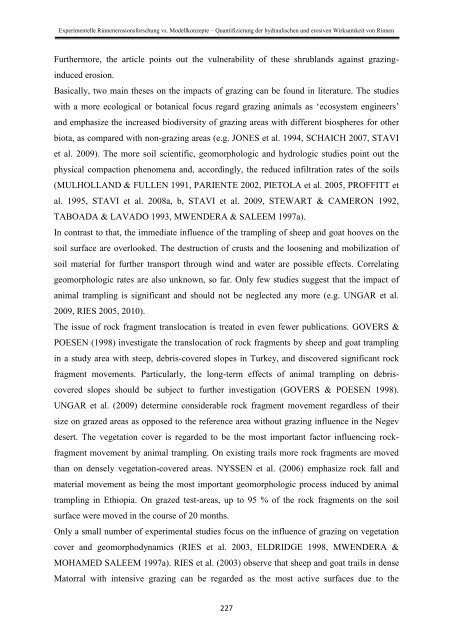Stefan Wirtz Vom Fachbereich VI (Geographie/Geowissenschaften ...
Stefan Wirtz Vom Fachbereich VI (Geographie/Geowissenschaften ...
Stefan Wirtz Vom Fachbereich VI (Geographie/Geowissenschaften ...
Create successful ePaper yourself
Turn your PDF publications into a flip-book with our unique Google optimized e-Paper software.
Experimentelle Rinnenerosionsforschung vs. Modellkonzepte – Quantifizierung der hydraulischen und erosiven Wirksamkeit von Rinnen<br />
Furthermore, the article points out the vulnerability of these shrublands against grazinginduced<br />
erosion.<br />
Basically, two main theses on the impacts of grazing can be found in literature. The studies<br />
with a more ecological or botanical focus regard grazing animals as ‘ecosystem engineers’<br />
and emphasize the increased biodiversity of grazing areas with different biospheres for other<br />
biota, as compared with non-grazing areas (e.g. JONES et al. 1994, SCHAICH 2007, STA<strong>VI</strong><br />
et al. 2009). The more soil scientific, geomorphologic and hydrologic studies point out the<br />
physical compaction phenomena and, accordingly, the reduced infiltration rates of the soils<br />
(MULHOLLAND & FULLEN 1991, PARIENTE 2002, PIETOLA et al. 2005, PROFFITT et<br />
al. 1995, STA<strong>VI</strong> et al. 2008a, b, STA<strong>VI</strong> et al. 2009, STEWART & CAMERON 1992,<br />
TABOADA & LAVADO 1993, MWENDERA & SALEEM 1997a).<br />
In contrast to that, the immediate influence of the trampling of sheep and goat hooves on the<br />
soil surface are overlooked. The destruction of crusts and the loosening and mobilization of<br />
soil material for further transport through wind and water are possible effects. Correlating<br />
geomorphologic rates are also unknown, so far. Only few studies suggest that the impact of<br />
animal trampling is significant and should not be neglected any more (e.g. UNGAR et al.<br />
2009, RIES 2005, 2010).<br />
The issue of rock fragment translocation is treated in even fewer publications. GOVERS &<br />
POESEN (1998) investigate the translocation of rock fragments by sheep and goat trampling<br />
in a study area with steep, debris-covered slopes in Turkey, and discovered significant rock<br />
fragment movements. Particularly, the long-term effects of animal trampling on debriscovered<br />
slopes should be subject to further investigation (GOVERS & POESEN 1998).<br />
UNGAR et al. (2009) determine considerable rock fragment movement regardless of their<br />
size on grazed areas as opposed to the reference area without grazing influence in the Negev<br />
desert. The vegetation cover is regarded to be the most important factor influencing rockfragment<br />
movement by animal trampling. On existing trails more rock fragments are moved<br />
than on densely vegetation-covered areas. NYSSEN et al. (2006) emphasize rock fall and<br />
material movement as being the most important geomorphologic process induced by animal<br />
trampling in Ethiopia. On grazed test-areas, up to 95 % of the rock fragments on the soil<br />
surface were moved in the course of 20 months.<br />
Only a small number of experimental studies focus on the influence of grazing on vegetation<br />
cover and geomorphodynamics (RIES et al. 2003, ELDRIDGE 1998, MWENDERA &<br />
MOHAMED SALEEM 1997a). RIES et al. (2003) observe that sheep and goat trails in dense<br />
Matorral with intensive grazing can be regarded as the most active surfaces due to the<br />
227
















